Abstract
The disialoganglioside GD2 is expressed on a wide spectrum of human tumor types, including neuroblastomas and melanomas. Upon binding of 3F8, a murine monoclonal antibody (MAb) specific for GD2, neuroblastomas and some melanomas are sensitive to killing by human complement, whereas some melanomas are not. To investigate the mechanism underlying these differences in complement mediated cytotoxicity, complement-insensitive melanoma cell lines were compared with respect to expression of the decay-accelerating factor (DAF), a membrane regulatory protein that protects blood cells from autologous complement attack. While DAF was undetectable among neuroblastomas, it was present in complement-insensitive melanomas. When the function of DAF was blocked by anti-DAF MAb, C3 uptake and complement-mediated lysis of the insensitive melanoma lines were markedly enhanced. F(ab')2 fragments were as effective in enhancing lysis as intact anti-DAF MAb. The DAF-negative and DAF-positive melanoma cell lines were comparably resistant to passive lysis by cobra venom factor-treated serum. The data suggest that in some tumors, DAF activity accounts for their resistance to complement-mediated killing. The ability to render these cells complement-sensitive by blocking DAF function may have implications for immunotherapy.
Full text
PDF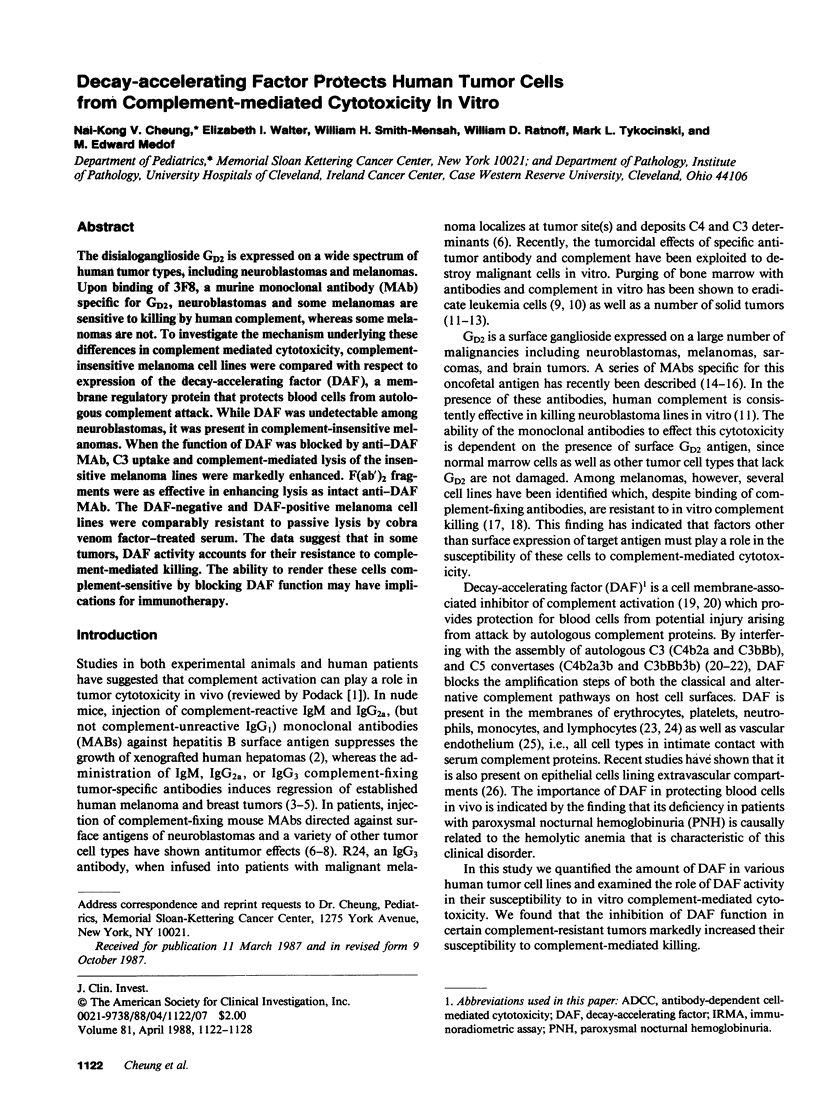

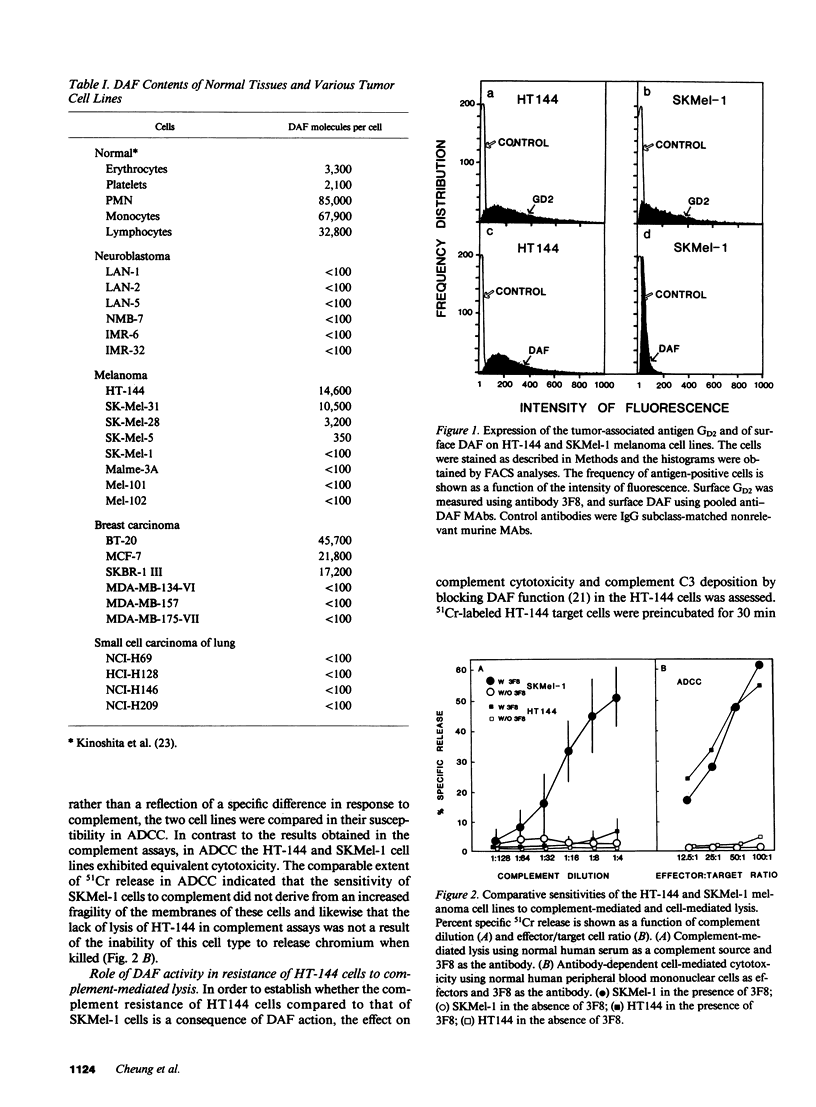
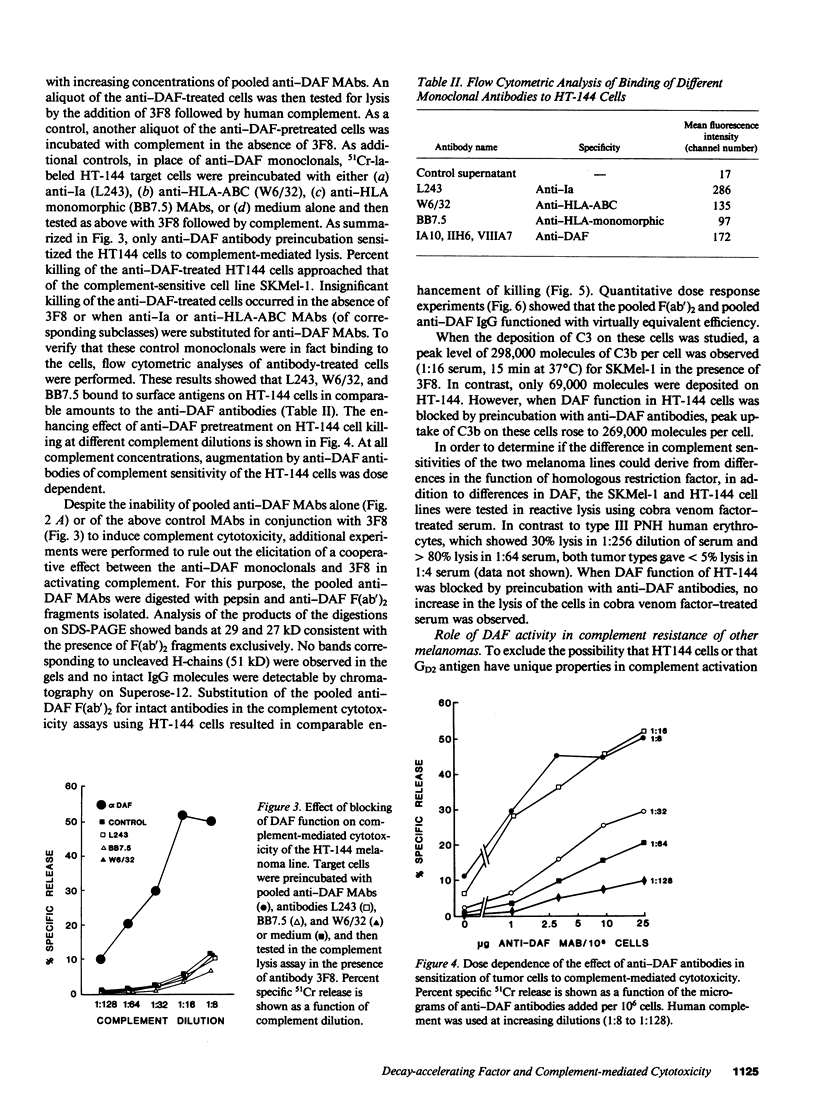
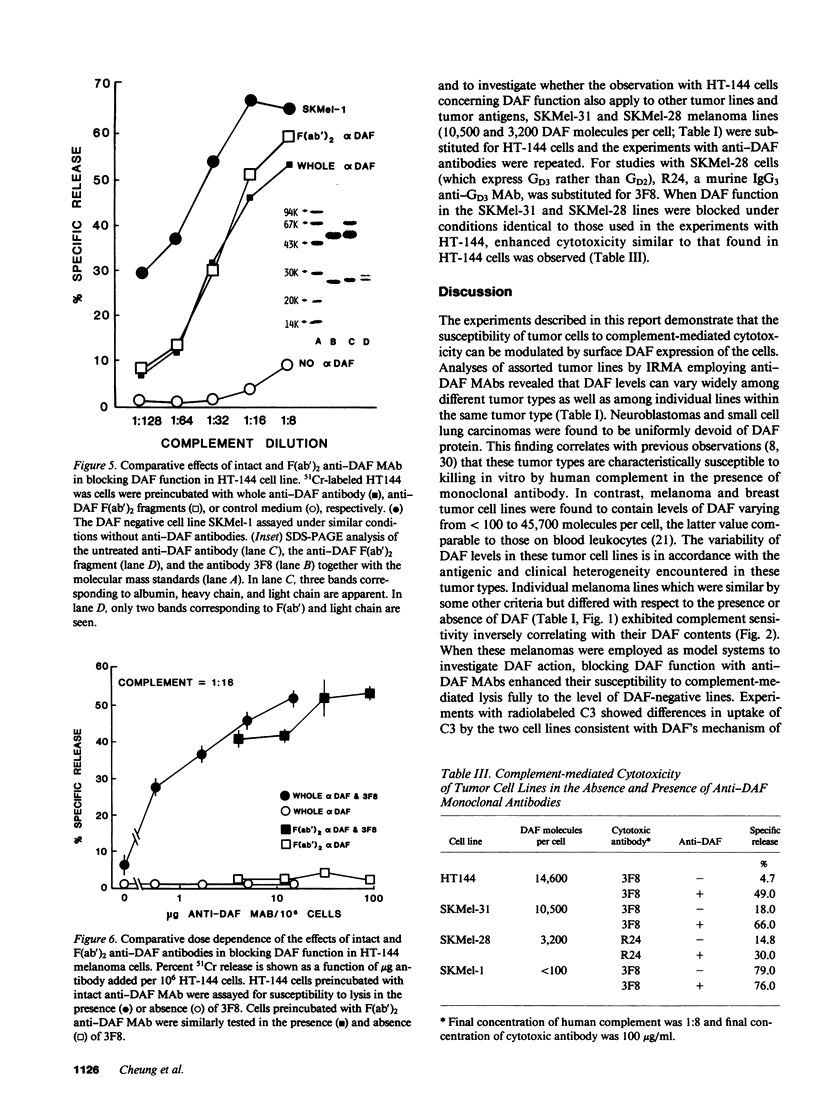
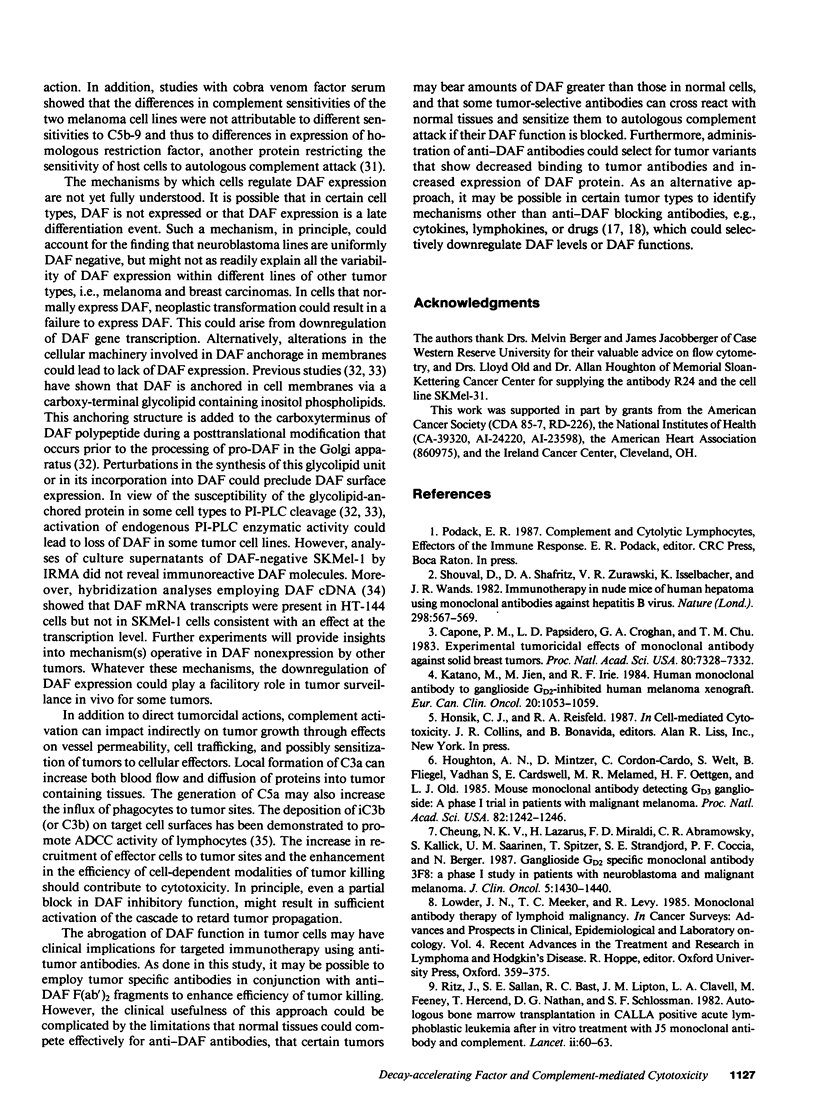
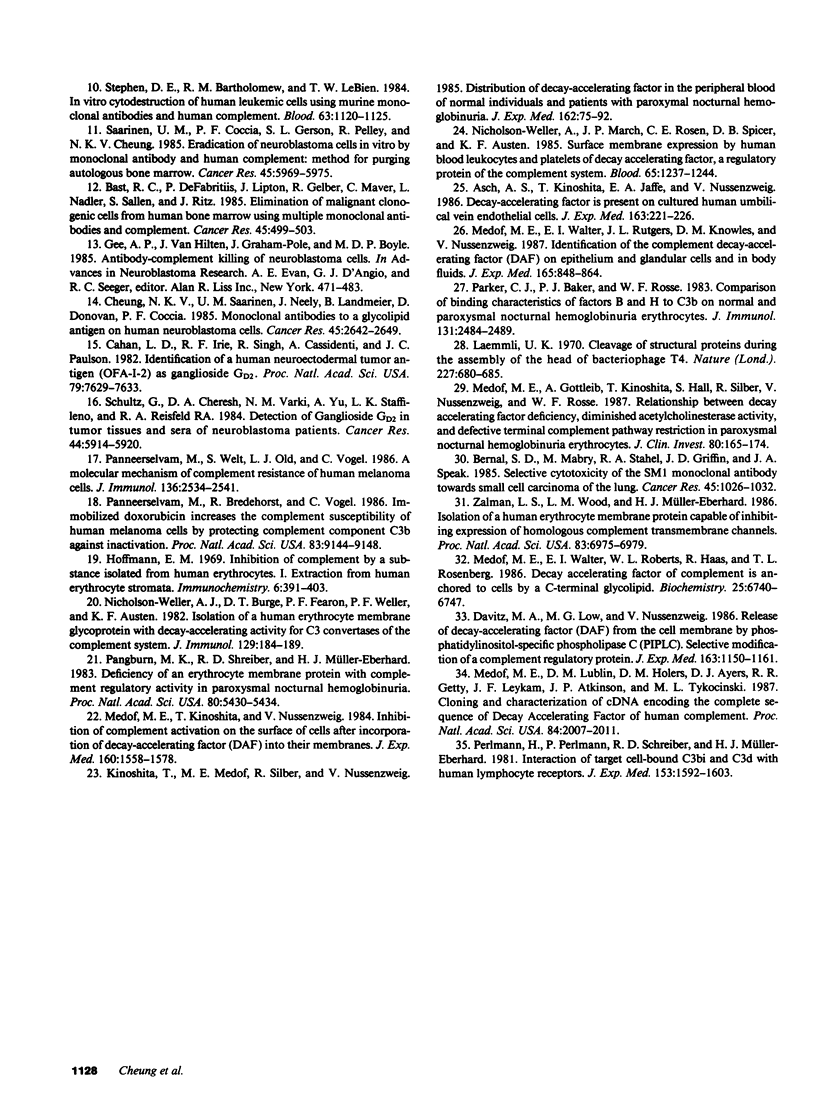
Selected References
These references are in PubMed. This may not be the complete list of references from this article.
- Asch A. S., Kinoshita T., Jaffe E. A., Nussenzweig V. Decay-accelerating factor is present on cultured human umbilical vein endothelial cells. J Exp Med. 1986 Jan 1;163(1):221–226. doi: 10.1084/jem.163.1.221. [DOI] [PMC free article] [PubMed] [Google Scholar]
- Bast R. C., Jr, De Fabritiis P., Lipton J., Gelber R., Maver C., Nadler L., Sallan S., Ritz J. Elimination of malignant clonogenic cells from human bone marrow using multiple monoclonal antibodies and complement. Cancer Res. 1985 Feb;45(2):499–503. [PubMed] [Google Scholar]
- Bernal S. D., Mabry M., Stahel R. A., Griffin J. D., Speak J. A. Selective cytotoxicity of the SM1 monoclonal antibody towards small cell carcinoma of the lung. Cancer Res. 1985 Mar;45(3):1026–1032. [PubMed] [Google Scholar]
- Cahan L. D., Irie R. F., Singh R., Cassidenti A., Paulson J. C. Identification of a human neuroectodermal tumor antigen (OFA-I-2) as ganglioside GD2. Proc Natl Acad Sci U S A. 1982 Dec;79(24):7629–7633. doi: 10.1073/pnas.79.24.7629. [DOI] [PMC free article] [PubMed] [Google Scholar]
- Capone P. M., Papsidero L. D., Croghan G. A., Chu T. M. Experimental tumoricidal effects of monoclonal antibody against solid breast tumors. Proc Natl Acad Sci U S A. 1983 Dec;80(23):7328–7332. doi: 10.1073/pnas.80.23.7328. [DOI] [PMC free article] [PubMed] [Google Scholar]
- Cheung N. K., Lazarus H., Miraldi F. D., Abramowsky C. R., Kallick S., Saarinen U. M., Spitzer T., Strandjord S. E., Coccia P. F., Berger N. A. Ganglioside GD2 specific monoclonal antibody 3F8: a phase I study in patients with neuroblastoma and malignant melanoma. J Clin Oncol. 1987 Sep;5(9):1430–1440. doi: 10.1200/JCO.1987.5.9.1430. [DOI] [PubMed] [Google Scholar]
- Cheung N. K., Saarinen U. M., Neely J. E., Landmeier B., Donovan D., Coccia P. F. Monoclonal antibodies to a glycolipid antigen on human neuroblastoma cells. Cancer Res. 1985 Jun;45(6):2642–2649. [PubMed] [Google Scholar]
- Davitz M. A., Low M. G., Nussenzweig V. Release of decay-accelerating factor (DAF) from the cell membrane by phosphatidylinositol-specific phospholipase C (PIPLC). Selective modification of a complement regulatory protein. J Exp Med. 1986 May 1;163(5):1150–1161. doi: 10.1084/jem.163.5.1150. [DOI] [PMC free article] [PubMed] [Google Scholar]
- Gee A. P., Van Hilten J., Graham-Pole J., Boyle M. D. Antibody-complement killing of neuroblastoma cells. Prog Clin Biol Res. 1985;175:471–483. [PubMed] [Google Scholar]
- Hoffman E. M. Inhibition of complement by a substance isolated from human erythrocytes. I. Extraction from human erythrocyte stromata. Immunochemistry. 1969 May;6(3):391–403. doi: 10.1016/0019-2791(69)90296-1. [DOI] [PubMed] [Google Scholar]
- Houghton A. N., Mintzer D., Cordon-Cardo C., Welt S., Fliegel B., Vadhan S., Carswell E., Melamed M. R., Oettgen H. F., Old L. J. Mouse monoclonal IgG3 antibody detecting GD3 ganglioside: a phase I trial in patients with malignant melanoma. Proc Natl Acad Sci U S A. 1985 Feb;82(4):1242–1246. doi: 10.1073/pnas.82.4.1242. [DOI] [PMC free article] [PubMed] [Google Scholar]
- Katano M., Jien M., Irie R. F. Human monoclonal antibody to ganglioside GD2-inhibited human melanoma xenograft. Eur J Cancer Clin Oncol. 1984 Aug;20(8):1053–1059. doi: 10.1016/0277-5379(84)90108-1. [DOI] [PubMed] [Google Scholar]
- Kinoshita T., Medof M. E., Silber R., Nussenzweig V. Distribution of decay-accelerating factor in the peripheral blood of normal individuals and patients with paroxysmal nocturnal hemoglobinuria. J Exp Med. 1985 Jul 1;162(1):75–92. doi: 10.1084/jem.162.1.75. [DOI] [PMC free article] [PubMed] [Google Scholar]
- Laemmli U. K. Cleavage of structural proteins during the assembly of the head of bacteriophage T4. Nature. 1970 Aug 15;227(5259):680–685. doi: 10.1038/227680a0. [DOI] [PubMed] [Google Scholar]
- Medof M. E., Gottlieb A., Kinoshita T., Hall S., Silber R., Nussenzweig V., Rosse W. F. Relationship between decay accelerating factor deficiency, diminished acetylcholinesterase activity, and defective terminal complement pathway restriction in paroxysmal nocturnal hemoglobinuria erythrocytes. J Clin Invest. 1987 Jul;80(1):165–174. doi: 10.1172/JCI113043. [DOI] [PMC free article] [PubMed] [Google Scholar]
- Medof M. E., Kinoshita T., Nussenzweig V. Inhibition of complement activation on the surface of cells after incorporation of decay-accelerating factor (DAF) into their membranes. J Exp Med. 1984 Nov 1;160(5):1558–1578. doi: 10.1084/jem.160.5.1558. [DOI] [PMC free article] [PubMed] [Google Scholar]
- Medof M. E., Lublin D. M., Holers V. M., Ayers D. J., Getty R. R., Leykam J. F., Atkinson J. P., Tykocinski M. L. Cloning and characterization of cDNAs encoding the complete sequence of decay-accelerating factor of human complement. Proc Natl Acad Sci U S A. 1987 Apr;84(7):2007–2011. doi: 10.1073/pnas.84.7.2007. [DOI] [PMC free article] [PubMed] [Google Scholar]
- Medof M. E., Walter E. I., Roberts W. L., Haas R., Rosenberry T. L. Decay accelerating factor of complement is anchored to cells by a C-terminal glycolipid. Biochemistry. 1986 Nov 4;25(22):6740–6747. doi: 10.1021/bi00370a003. [DOI] [PubMed] [Google Scholar]
- Medof M. E., Walter E. I., Rutgers J. L., Knowles D. M., Nussenzweig V. Identification of the complement decay-accelerating factor (DAF) on epithelium and glandular cells and in body fluids. J Exp Med. 1987 Mar 1;165(3):848–864. doi: 10.1084/jem.165.3.848. [DOI] [PMC free article] [PubMed] [Google Scholar]
- Nicholson-Weller A., Burge J., Fearon D. T., Weller P. F., Austen K. F. Isolation of a human erythrocyte membrane glycoprotein with decay-accelerating activity for C3 convertases of the complement system. J Immunol. 1982 Jul;129(1):184–189. [PubMed] [Google Scholar]
- Nicholson-Weller A., March J. P., Rosen C. E., Spicer D. B., Austen K. F. Surface membrane expression by human blood leukocytes and platelets of decay-accelerating factor, a regulatory protein of the complement system. Blood. 1985 May;65(5):1237–1244. [PubMed] [Google Scholar]
- Pangburn M. K., Schreiber R. D., Müller-Eberhard H. J. Deficiency of an erythrocyte membrane protein with complement regulatory activity in paroxysmal nocturnal hemoglobinuria. Proc Natl Acad Sci U S A. 1983 Sep;80(17):5430–5434. doi: 10.1073/pnas.80.17.5430. [DOI] [PMC free article] [PubMed] [Google Scholar]
- Panneerselvam M., Bredehorst R., Vogel C. W. Immobilized doxorubicin increases the complement susceptibility of human melanoma cells by protecting complement component C3b against inactivation. Proc Natl Acad Sci U S A. 1986 Dec;83(23):9144–9148. doi: 10.1073/pnas.83.23.9144. [DOI] [PMC free article] [PubMed] [Google Scholar]
- Panneerselvam M., Welt S., Old L. J., Vogel C. W. A molecular mechanism of complement resistance of human melanoma cells. J Immunol. 1986 Apr 1;136(7):2534–2541. [PubMed] [Google Scholar]
- Parker C. J., Baker P. J., Rosse W. F. Comparison of binding characteristics of factors B and H to C3b on normal and paroxysmal nocturnal hemoglobinuria erythrocytes. J Immunol. 1983 Nov;131(5):2484–2489. [PubMed] [Google Scholar]
- Perlmann H., Perlmann P., Schreiber R. D., Müller-Eberhard H. J. Interaction of target cell-bound C3bi and C3d with human lymphocyte receptors. Enhancement of antibody-mediated cellular cytotoxicity. J Exp Med. 1981 Jun 1;153(6):1592–1603. doi: 10.1084/jem.153.6.1592. [DOI] [PMC free article] [PubMed] [Google Scholar]
- Ritz J., Sallan S. E., Bast R. C., Jr, Lipton J. M., Clavell L. A., Feeney M., Hercend T., Nathan D. G., Schlossman S. F. Autologous bone-marrow transplantation in CALLA-positive acute lymphoblastic leukemia after in-vitro treatment with J5 monoclonal antibody and complement. Lancet. 1982 Jul 10;2(8289):60–63. doi: 10.1016/s0140-6736(82)91686-5. [DOI] [PubMed] [Google Scholar]
- Saarinen U. M., Coccia P. F., Gerson S. L., Pelley R., Cheung N. K. Eradication of neuroblastoma cells in vitro by monoclonal antibody and human complement: method for purging autologous bone marrow. Cancer Res. 1985 Nov;45(11 Pt 2):5969–5975. [PubMed] [Google Scholar]
- Schulz G., Cheresh D. A., Varki N. M., Yu A., Staffileno L. K., Reisfeld R. A. Detection of ganglioside GD2 in tumor tissues and sera of neuroblastoma patients. Cancer Res. 1984 Dec;44(12 Pt 1):5914–5920. [PubMed] [Google Scholar]
- Shouval D., Shafritz D. A., Zurawski V. R., Jr, Isselbacher K. J., Wands J. R. Immunotherapy in nude mice of human hepatoma using monoclonal antibodies against hepatitis B virus. Nature. 1982 Aug 5;298(5874):567–569. doi: 10.1038/298567a0. [DOI] [PubMed] [Google Scholar]
- Stepan D. E., Bartholomew R. M., LeBien T. W. In vitro cytodestruction of human leukemic cells using murine monoclonal antibodies and human complement. Blood. 1984 May;63(5):1120–1124. [PubMed] [Google Scholar]
- Zalman L. S., Wood L. M., Müller-Eberhard H. J. Isolation of a human erythrocyte membrane protein capable of inhibiting expression of homologous complement transmembrane channels. Proc Natl Acad Sci U S A. 1986 Sep;83(18):6975–6979. doi: 10.1073/pnas.83.18.6975. [DOI] [PMC free article] [PubMed] [Google Scholar]


